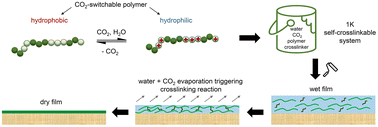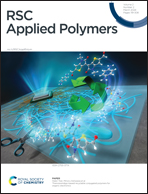Crosslinking CO2-switchable polymers for paints and coatings applications†
Abstract
The emission of volatile organic compounds (VOCs) from solvent-based paints and coatings and its detrimental effect on humans and the environment have encouraged the industry to move towards more environmentally friendly options. Water-based paints and coatings, however, require a complex film formation process involving the coalescence of colloidal polymeric particles in the aqueous medium which adversely affects the critical properties of the film. Despite the advances in water-based formulations, they are still outperformed by solvent-based coatings, particularly in high performance applications. Our group previously demonstrated the potential of CO2-switchable polymers in paints and coatings applications to achieve an aqueous zero-VOC formulation that uses the same film formation process as solvent-based formulations. The normally water-insoluble CO2-switchable polymer can be fully dissolved in carbonated water rather than organic solvents. Subsequently, upon application of the solution to a surface, the polymer switches to a water-insoluble form as the CO2 and water evaporate. This technology offers both environmental friendliness and high performance. In this study, we focus on improving the solvent resistance of the resulting coatings by utilizing a crosslinking reaction. In order to achieve a 1K crosslinking system, the crosslinking reaction should be hindered when CO2 is present to achieve stability and occur during the film formation process as the CO2 evaporates. To accomplish this goal, possible reactions are initially investigated using model compounds that mimic the structure of the polymer and crosslinking agent in terms of their reactivity in the presence and absence of CO2. The promising candidates were then applied in a coating formulation and evaluated in terms of the performance of the crosslinked coatings and the stability of the formulation.

- This article is part of the themed collections: Sustainable Development Goal 12: Responsible Production and Consumption and Editor’s Choice – Emily Pentzer


 Please wait while we load your content...
Please wait while we load your content...